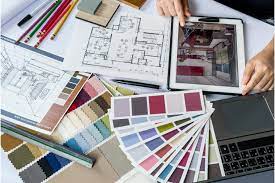Interior designers evaluate space requirements and choose furniture, lighting, layout, materials, and colors to suit their clients’ demands and styles. Experience, industry, organization size, and region affect interior designer salaries. Read further to learn more about their job.
Interior Designer
A specialist in constructing interior spaces that are both visually beautiful and useful is known as an interior designer. In order to create environments that represent their client’s individual tastes and demands, interior designers receive specialized training. They collaborate with clients to create design concepts and plans that consider elements like material selection, lighting, color, and the layout of the space. In order to create spaces that are not only attractive but also practical and safe, interior designers frequently work with architects, engineers, and other specialists on a variety of projects, from personal residences to commercial structures.
A degree in interior design, architecture, or a similar discipline is often required to work as an interior designer. Interior designers frequently receive experience through internships or apprenticeships in addition to formal study. Many also pursue professional qualifications or participation in industry associations. Interior designers are crucial in influencing the environments we live in and raising the standard of our lives thanks to their technical expertise and artistic vision.
A degree in interior design, architecture, or a similar discipline is often required to work as an interior designer. Interior designers frequently receive experience through internships or apprenticeships in addition to formal study. Many also pursue professional qualifications or participation in industry associations. Interior designers are crucial in influencing the environments we live in and raising the standard of our lives thanks to their technical expertise and artistic
Interior Designer Job Description
By evaluating space needs, choosing the best furniture placement, and choosing ornamental objects while following pertinent blueprints, building codes, and inspection criteria, the interior designer will create useful, secure, and visually beautiful environments.
Duty and Responsibilities
Depending on the particular project and the extent of their engagement, an interior designer may have different obligations and responsibilities. However, among the regular duties and obligations of interior designers are:
- Interior designers meet with clients to assess their needs, preferences, and financial constraints. They evaluate the room’s possibilities while taking into account the client’s lifestyle, aspirations, and preferences.
- Creating design concepts: Interior designers create design concepts that incorporate floor plans, color schemes, materials, and furnishings based on their evaluation of the area and the needs of the customer. For their clients’ benefit, they produce sketches or computer-generated pictures of the design.
- Making precise blueprints: Following the approval of a design concept, interior designers make precise plans that define the materials, finishes, and fixtures that will be used. To explain the design to contractors, builders, and other specialists, they produce working drawings and papers.
- Interior designers may supervise the building or installation of the design to make sure everything is carried out on schedule and according to the plan. Additionally, they might coordinate with other experts including contractors, architects, and engineers.
- Ensuring compliance and safety: Interior designers are required to make sure that their designs abide by all applicable building codes, safety standards, and other legal restrictions. They need to be knowledgeable about the accessibility needs of those with disabilities and make sure the area is secure and useful.
- Budget management: Interior designers must be able to control costs and work within the client’s budget. To prevent cost overruns, they must be able to produce precise cost predictions and control spending.
Skills/Abilities Needed
- Detail-oriented with strong organizing and problem-solving abilities.
- The capacity to use style to design interiors that are aesthetically pleasing.
- Strong aptitude for proportion and aesthetics in visual design.
- Excellent communication skills, both in writing and speaking.
- Knowledge of and proficiency with CAD software.
- Competent with the microsoft Office suite or comparable programs.
- Basic knowledge of interior building codes and inspection requirements.
Education and Work History
- Requires a bachelor’s degree in interior design or a closely related subject; strongly preferred: training in computer-aided design (CAD).
- Highly preferred certification in interior design.
- Experience in the field for at least a year is necessary.
Physical Prerequisites
- Prolonged time spent using a computer while seated at a desk.
- Must occasionally be able to lift up to 15 pounds.
- Should be able to tell colors apart.
Types of Interior Designers
Interior designers come in a variety of forms, each with its own unique specialties and areas of experience. The following are some of the most typical types of interior designers:
- Interior designers with a focus on domestic areas, such as homes, apartments, and other living quarters, are known as residential interior designers. They might work in jobs ranging from modest apartments to huge, luxurious estates.
- Designers of efficient and appealing interior spaces for commercial structures, such as offices, hotels, restaurants, and retail establishments, fall under the category of commercial interior designers. They could be hired to work on anything from modest retail spaces to huge corporate buildings.
- Interior designers with a focus on the hospitality industry create warm, welcoming, and practical spaces for hotels, resorts, and other hospitality-related establishments. They might work on jobs ranging from tiny hotel rooms to sizable public areas like lobbies and dining rooms.
- Hospitals, clinics, and other healthcare institutions benefit from the functional and therapeutic interior designs produced by these designers. They could concentrate on issues including the patient’s convenience, security, and accessibility, as well as the requirements of the medical team and other caregivers.
- Sustainable interior designers: These designers concentrate on producing green, sustainable designs that reduce their negative effects on the environment and encourage healthy living. Eco-friendly building materials and finishes, as well as energy-saving lighting and HVAC systems, may be used.
- Set designers are artists that specialize in designing interiors for stage, screen, and television productions. They might design sets that faithfully depict a certain era or region or that evoke a particular feeling or ambiance.
Salary for an Interior Designer
As of June 26, 2023, the average compensation for interior designers in the United States is $50,832, however, the range frequently lies between $40,303 and $55,741. Salary ranges can vary significantly depending on a variety of crucial aspects, including schooling, credentials, supplementary talents, and the length of time you’ve been working in a given field. Salary.com assists you in determining your precise pay target by providing more online, real-time compensation data than any other website.
What Is Another Name for an Interior Designer?
The terms interior decorator and interior designer are frequently used interchangeably.
What Skills Do You Need for Interior Design?
Every interior designer needs to have six essential skills.
- Attention to detail and a creative eye. Most importantly, you’ll need to be really imaginative.
- Identification of trends.
- Understanding of sustainable methods.
- Superiority in communication.
- Proficiency with computers and drawing.
- Organization.
What Is Interior Design and Decorator?
With extra skills in creating floor plans and using design software, an interior designer frequently collaborates closely with architects and other experts to make an interior space beautiful, safe, and useful.
- Education: The field of interior design calls for specific education and formal training. The labor involved typically entails researching color and fabric, receiving CAD training, drawing, organizing the use of space, creating furniture designs, and more. Before starting their own businesses after graduating, designers frequently work as apprentices for licensed and reputable interior designers.
- Qualifications: Professional designers must pass an exam and register with a governing body (which depends on the nation, state, or province they are in) in order to be able to use the title “designer” in some states and provinces. However, there are just as many places that don’t require credentials. So before beginning your quest, it’s a good idea to research the situation in your neighborhood.
- How they act: Since they are adept in spatial planning, designers may assist with interior design and renovation projects, from creating the first floor plans to placing the final decorative accent. Designers improve a room’s functionality in addition to its appearance.
- They collaborate with Whether a client is creating a residential house, an office, a hotel, or any other interior space, interior designers frequently collaborate closely with architects and constructors to create the aesthetic the client desires.
Who is an Interior Decorator?
An expert at beautifying a space with design, color, furniture, and accessories is an interior decorator. They collaborate closely with upholsterers, furniture producers, and other experts in home decor to provide their clients with interior environments that appeal to the eye.
- Education: Since interior decorators generally concentrate on aesthetics and don’t take part in restorations or structural planning, they are not necessary to have formal training or education in order to practice professionally. After the structural planning and execution are finished, a decorator is brought in to focus on the space’s exterior appearance. Although it is not necessary for the job, many professional interior decorators hold college degrees in related subjects.
- Credentials: Although formal education is not necessary to become an interior decorator, there are numerous programs and courses available. These classes frequently cover topics including color, fabric, furniture designs, room layouts, and space planning. Organizations like C.I.D. (certified interior decorators international) certifications provide education and certification to assist decorators in validating their methods.
- How they act: Good decorators are adept at entering a space and giving it a fresh new look. They can assist clients in choosing a design and color palette for new areas as well as furniture and accessories. They are frequently used to brighten up an area that already exists but needs to be upgraded or redone.
- They collaborate with Since structural work is typically finished before contractors or architects join the project, decorators rarely collaborate with them. They nevertheless collaborate with upholsterers, furniture makers, and other business experts. However, they typically deal directly with property owners or business management.
What Is the Difference Between Architect and Interior Designer?
Simply said, architects create the exteriors of structures, and interior designers create the interiors. An architect is in charge of the most intricate design elements. When a structure is finished being created, interior designers decorate and fill the vacant spaces.
An architect works on structures and is educated to create them from scratch, which is how they differ from interior designers. Instead of starting from scratch, interior designers modify the structure, furnishings, and other décor elements of a room to achieve the desired aesthetic.
Although they both use their creativity to improve the lives of others, interior designers and architects play very distinct roles.
Does Interior Design Include Furniture?
The majority of a room’s visual components—the flooring, ceiling, walls, furniture, lights, upholstery, doors, windows, electronics, and accessories—are included in interior design. It also includes unnoticed components like plumbing, electrical wiring, cement and plaster, and hardware.
Who Earns More Interior Designer or Architect?
Architects have a greater duty to ensure that their buildings remain standing, and they also require tighter admission requirements to practice; hence, interior designers typically make less money over the course of their careers.
Which Is Better Interior Design or Fashion Design?
While interior construction is expensive and stressful to redo if there is a mistake, fashion creations are simple to adapt to and adjust to. Therefore, it might be claimed that interior design is under additional pressure to complete the job correctly the first time.
Related Articles
- HOW TO BECOME AN INTERIOR DECORATOR: Skills, Certification & Requirements
- INTERIOR DECORATION BUSINESS: A blueprint to follow in 2022 without a degree (+ Detailed Guide)
- Commercial Interior Design: A Guide






